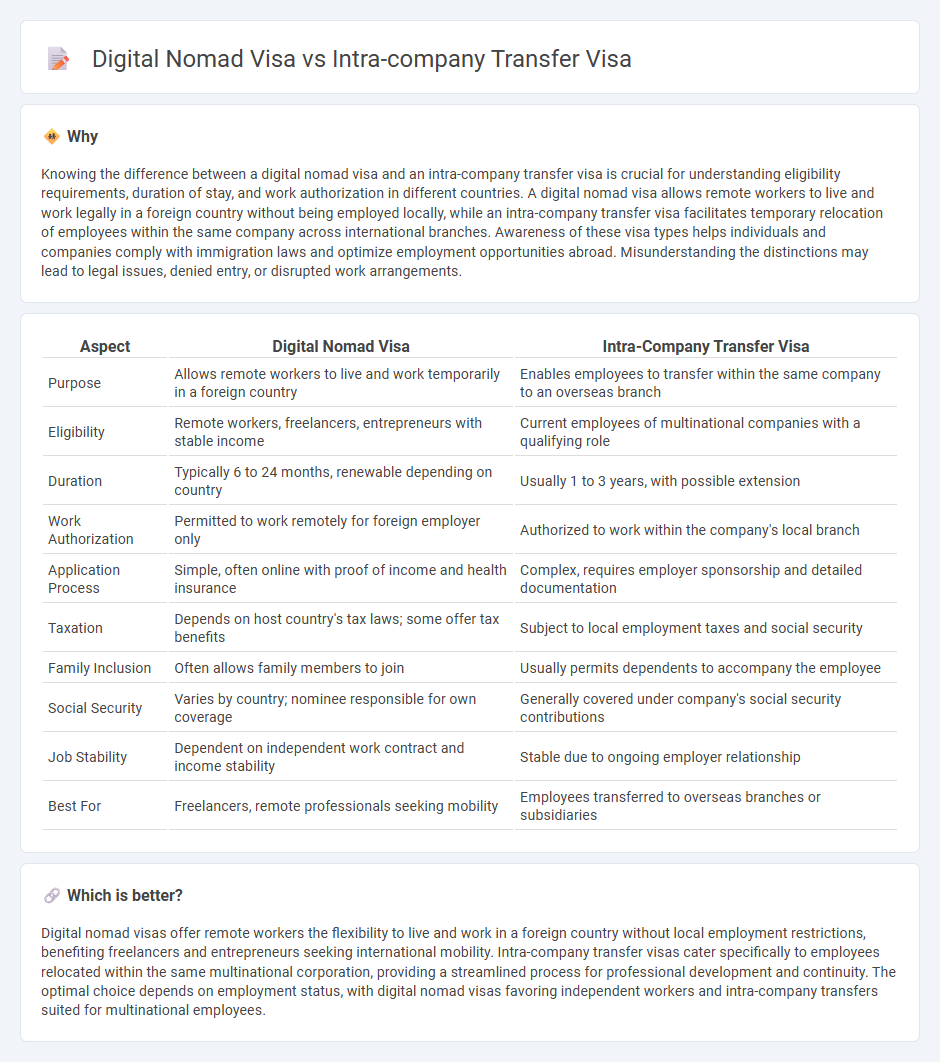
Digital nomad visas enable remote workers to reside temporarily in a foreign country while maintaining employment with their home-based company, promoting flexibility and global work experiences. Intra-company transfer visas facilitate the relocation of existing employees to a branch or affiliate office abroad, focusing on continuity and business operations within multinational corporations. Explore the key differences and benefits of these visa options to determine which best suits your employment needs.
Why it is important
Knowing the difference between a digital nomad visa and an intra-company transfer visa is crucial for understanding eligibility requirements, duration of stay, and work authorization in different countries. A digital nomad visa allows remote workers to live and work legally in a foreign country without being employed locally, while an intra-company transfer visa facilitates temporary relocation of employees within the same company across international branches. Awareness of these visa types helps individuals and companies comply with immigration laws and optimize employment opportunities abroad. Misunderstanding the distinctions may lead to legal issues, denied entry, or disrupted work arrangements.
Comparison Table
| Aspect | Digital Nomad Visa | Intra-Company Transfer Visa |
|---|---|---|
| Purpose | Allows remote workers to live and work temporarily in a foreign country | Enables employees to transfer within the same company to an overseas branch |
| Eligibility | Remote workers, freelancers, entrepreneurs with stable income | Current employees of multinational companies with a qualifying role |
| Duration | Typically 6 to 24 months, renewable depending on country | Usually 1 to 3 years, with possible extension |
| Work Authorization | Permitted to work remotely for foreign employer only | Authorized to work within the company's local branch |
| Application Process | Simple, often online with proof of income and health insurance | Complex, requires employer sponsorship and detailed documentation |
| Taxation | Depends on host country's tax laws; some offer tax benefits | Subject to local employment taxes and social security |
| Family Inclusion | Often allows family members to join | Usually permits dependents to accompany the employee |
| Social Security | Varies by country; nominee responsible for own coverage | Generally covered under company's social security contributions |
| Job Stability | Dependent on independent work contract and income stability | Stable due to ongoing employer relationship |
| Best For | Freelancers, remote professionals seeking mobility | Employees transferred to overseas branches or subsidiaries |
Which is better?
Digital nomad visas offer remote workers the flexibility to live and work in a foreign country without local employment restrictions, benefiting freelancers and entrepreneurs seeking international mobility. Intra-company transfer visas cater specifically to employees relocated within the same multinational corporation, providing a streamlined process for professional development and continuity. The optimal choice depends on employment status, with digital nomad visas favoring independent workers and intra-company transfers suited for multinational employees.
Connection
Digital nomad visas and intra-company transfer visas both facilitate remote work but serve different employment scenarios; digital nomad visas enable professionals to work independently from abroad without local employment, while intra-company transfer visas allow employees to relocate temporarily to a foreign branch of their current employer. Both visa types support global workforce mobility and expand opportunities for international employment and collaboration. Employers benefit by leveraging talent across borders, promoting flexibility and operational continuity.
Key Terms
Sponsorship
An intra-company transfer visa requires sponsorship from the employer, ensuring legal authorization and job continuity within the same organization across international branches. In contrast, a digital nomad visa typically does not require employer sponsorship, catering to remote workers who can independently prove sufficient income and work flexibility without local employment ties. Explore the specific sponsorship criteria and benefits of each visa type to determine the best fit for your work situation.
Remote Work
Intra-company transfer visas enable employees to work remotely within the same organization across different countries, providing stability and continuity under corporate sponsorship while complying with immigration regulations. Digital nomad visas cater to freelancers or remote workers seeking flexible location options without employer constraints, often offering extended stays and simplified application processes. Explore how each visa type aligns with your remote work lifestyle and professional goals to make an informed decision.
Employer Relationship
Intra-company transfer visas require a strong employer-employee relationship where the individual is relocated within the same company, ensuring continued employment and benefits. Digital nomad visas cater to remote workers who maintain independent contracts or self-employment without direct ties to a local employer. Explore the nuances and eligibility criteria of each visa to determine the best fit for your professional mobility needs.
Source and External Links
L-1 Visa | Intra Company Transfer Visa | How to Apply | IAS - The L-1 visa allows employees in executive, managerial, or specialized knowledge roles to transfer to a US-based office of the same company or its affiliate, requiring at least one year of employment abroad with the company within the last three years.
What is an Intra-Company Transfer? | A Guide to ICT Visa ... - Intra-company transfer visas facilitate relocating employees with managerial, executive, or specialized knowledge roles between branches, subsidiaries, or affiliates across countries, with common eligibility including prior service of 6-12 months and role alignment with business needs.
L-1: Intracompany Transfer Visas - The L-1 visa enables foreign companies to send key employees to the US to work at an affiliated branch, supports dual intent for eventual green card application, and requires a qualifying relationship between the foreign and US employers.
 dowidth.com
dowidth.com